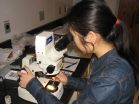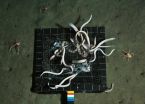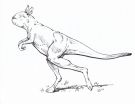(Press-News.org) Removal of the entire lobe of lung may offer patients with early-stage lung cancer better overall survival when compared with a partial resection, and stereotactic ablative radiotherapy (SABR) may offer the same survival benefit as a lobectomy for some patients, according to a study from The University of Texas MD Anderson Cancer Center.
The research is the largest population-based study to review modern treatment modalities for early-stage lung cancer and is published in JAMA Surgery.
According to the American Cancer Society, in 2014, 224,210 people in the U.S. are expected to be diagnosed with lung cancer, and more than 159,260 will die from the disease. Yet with the aging baby-boomer population colliding with spiral CT-screening's acceptance as a screening tool for lung cancer, the number of cases diagnosed is expected to rise dramatically, says Shervin M. Shirvani, M.D., attending radiation oncologist at Banner MD Anderson Cancer Center in Arizona and an adjunct professor at MD Anderson.
The disease is typically a cancer of the elderly, and because of its association with smoking, patients often carry other comorbidities, such as COPD, coronary artery disease and renal failure.
Three treatment options are widely available for patients with early-stage disease: lobectomy, or removal of the entire lobe of lung; sublobar resection, or removal of the part of the lung that contains the tumor; and SABR, a precise form of radiation therapy delivered over three to five sessions.
"Currently, lung cancer is one of the most common and fatal cancers, and for the foreseeable future it will be one of the major health epidemics our country faces. Yet we don't have strong evidence-based guidelines for how to best treat the disease – especially when it's discovered early," says Shirvani, the study's first author.
Several randomized trials to compare the three modalities have been attempted, but each has been set back by low accrual and lack of participation by patients and physicians, he explains.
"In the absence of clinical trials, it was important to analyze observational data from a very large database to compare these three modalities. We wanted to compare lobectomy, the treatment generally thought to be the standard of care, to both the smaller surgery and stereotactic ablative radiotherapy, which does not carry surgical risk, and understand which may be best for this elderly patient population with extensive concurrent illnesses."
For the retrospective, population-based study, the researchers analyzed the Surveillance, Epidemiology and End Results (SEER) Medicare database to identify patients treated for non-small cell lung cancer between 2003 and 2009. In total 9,093 patients were identified. All received one of three treatment strategies: lobectomy (7,215 patients, or 79.3 percent); sublobar resection (1,496 patients, or 16.5 percent); and SABR (382 patients, or 4.2 percent). Of note, says Shirvani, is that the study's time-period reflects the earliest adopters of SABR.
Adjusting for characteristics associated with the patient, the tumor, economic factors and other co-variables, the researchers found that the lobectomy was associated with better overall and lung-specific survival, when compared to sublobar resection, a finding that surprised the researchers.
"The assumption was that for an elderly patient with a number of co-morbidities, the smaller surgery would be better than a whole lobectomy because there would be fewer surgical complications. Yet, it appears that the ability to eradicate the cancer with the bigger surgery may be more important than minimizing surgical risk," he explained.
When patients with similar baseline characteristics treated with lobectomy and SABR were compared, the two modalities were associated with similar overall survival and lung-cancer specific. This suggests that SABR is a very promising alternative to surgery for patients with very advanced age and multiple medical problems, features commonly observed in the matched populations.
While observational, Benjamin Smith, M.D., associate professor, Radiation Oncology at MD Anderson, hopes that the physicians will begin to exercise caution with the belief that a smaller surgery is better-suited for this patient population.
"Clearly, the incidence of early-stage lung cancer will increase dramatically in the next few years, and we need to be prepared to treat patients in the right way – balancing the effectiveness versus risk of treatment in an elderly population," says Smith, the study's corresponding author.
"Observational studies like ours give us insight into what the right treatment strategy should be, and hopefully will encourage both physicians and patients that prospective clinical trials are worth pursuing," he continued.
INFORMATION:
In addition to Shirvani and Smith, other researchers on the study include, from MD Anderson: Thomas A. Buchholz, M.D., Executive Vice President and Physician-In-Chief; Stephen G. Swisher, M.D., professor and Division Head, Surgery; Joe Y. Chang, M.D., Ph.D., professor, and James Welsh, M.D., associate professor, both with Radiation Oncology; and Jing Jiang, Health Services Research. From Banner MD Anderson, Anna Likhacheva, M.D., Department of Radiation Oncology, is also an author.
The following authors declare conflicts: Welsh has served as a consultant at Reflexion Medical; Likahacheva has received research funds from Elekta Incorporated; and Swisher has served as a consultant at GlaxoSmithKline.
TORONTO, Oct 15, 2014 – Few topics can prove more divisive than religion, with some insisting it promotes compassion, selflessness and generosity, and others arguing that it leads to intolerance, isolation and even violence.
New research conducted at York University, published in the Journal of Personality and Social Psychology, may shed some light on religion's actual influence on believers – and the news is positive.
"Based on our premise that most people's religious beliefs are non-hostile and magnanimous, we hypothesized that being reminded of religious ...
New York, NY, October 16, 2014 – Evidence-based guidelines play an increasing role in setting standards for medical practice and quality but are seldom systematically evaluated in the practice setting. Investigators evaluated the rate of physician adherence to the American Urological Association's (AUA) guidelines on the management of benign prostatic hyperplasia/lower urinary tract symptoms (BPH/LUTS) to establish a benchmark for future research. Their findings are published in The Journal of Urology®.
Medical certification bodies, for example, the American ...
NASA's Aqua satellite passed over intensifying Tropical Storm Ana as it was moving through the Central Pacific Ocean and toward the Hawaiian Islands.
On Oct. 14 at 22:50 UTC (6:50 p.m. EDT) the MODIS instrument aboard NASA's Aqua satellite captured a visible image of Tropical Storm Ana in the Central Pacific Ocean. The MODIS image showed a tight concentration of thunderstorms surrounding the center of Ana's circulation.
At 1500 UTC (11 a.m. EDT/5 a.m. HST) on Wed. Oct. 15, Tropical Storm Ana's maximum sustained winds were near 70 mph (110 kph). Ana is forecast to gradually ...
VIDEO:
This animation of visible and infrared images from NOAA's GOES-East satellite shows the movement and strengthening of Gonzalo from a tropical storm on Oct. 13 to a hurricane on Oct....
Click here for more information.
Hurricane Gonzalo has made the jump to major hurricane status and on Oct. 15 was a Category 4 storm on the Saffir-Simpson Hurricane Scale. NOAA's GOES-East satellite provided imagery of the storm. According to the National Hurricane Center, Gonzalo is the ...
Nanomedicines consisting of nanoparticles for targeted drug delivery to specific tissues and cells offer new solutions for cancer diagnosis and therapy. Understanding the interdependency of physiochemical properties of nanomedicines, in correlation to their biological responses and functions, is crucial for their further development of as cancer-fighters.
"To develop next generation nanomedicines with superior anti-cancer attributes, we must understand the correlation between their physicochemical properties—specifically, particle size—and their interactions ...
Researchers in Syracuse University's College of Arts and Sciences are pairing chemical analyses with micropaleontology—the study of tiny fossilized organisms—to better understand how global marine life was affected by a rapid warming event more than 55 million years ago.
Their findings are the subject of an article in the journal Paleoceanography (John Wiley & Sons, 2014).
"Global warming impacts marine life in complex ways, of which the loss of dissolved oxygen [a condition known as hypoxia] is a growing concern" says Zunli Lu, assistant professor of ...
A new study using a reconstruction of North American drought history over the last 1,000 years found that the drought of 1934 was the driest and most widespread of the last millennium.
Using a tree-ring-based drought record from the years 1000 to 2005 and modern records, scientists from NASA and Lamont-Doherty Earth Observatory found the 1934 drought was 30 percent more severe than the runner-up drought (in 1580) and extended across 71.6 percent of western North America. For comparison, the average extent of the 2012 drought was 59.7 percent.
"It was the worst by a ...
This week, researchers from University of Hawai'i, Norway, and the UK have shown with innovative experiments that a rise in jellyfish blooms near the ocean's surface may lead to jellyfish falls that are rapidly consumed by voracious deep-sea scavengers. Previous anecdotal studies suggested that deep-sea animals might avoid dead jellyfish, causing dead jellyfish from blooms to accumulate and undergo slow degradation by microbes, depleting oxygen at the seafloor and depriving fish and invertebrate scavengers, including commercially exploited species, of food.
Globally ...
PROVIDENCE, R.I. [Brown University] — Imagine that a time machine has transported you to the Australian outback 100,000 years ago. As you emerge, you see a huge kangaroo with a round rabbit-like face foraging in a tall bush nearby. The animal's surprising size makes you gasp aloud but when it hears you, becoming equally unnerved, it doesn't hop or lumber away on all fours and tail like every kangaroo you've seen in the present. It walks on its feet. One at a time. Like you.
In a new paper in the journal PLoS ONE, a team of researchers led by Christine Janis, professor ...
Now extinct giant kangaroos most likely could not hop and used a more rigid body posture to move their hindlimbs one at a time, according to a study published October 15, 2014 in the open-access journal PLOS ONE by Christine Janis from Brown University and colleagues.
The "short-faced," large-bodied sthenurine kangaroos–a now extinct relative to modern-day kangaroos–first appeared in the middle Miocene and became extinct in the late Pleistocene. The largest of these kangaroos had an estimated body mass of 240 kg, almost three times the size of the largest ...






